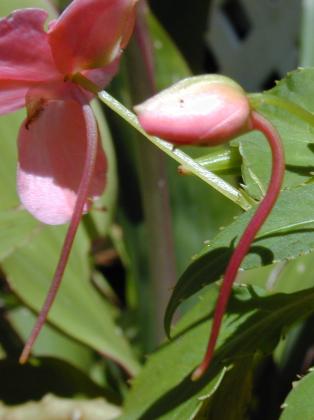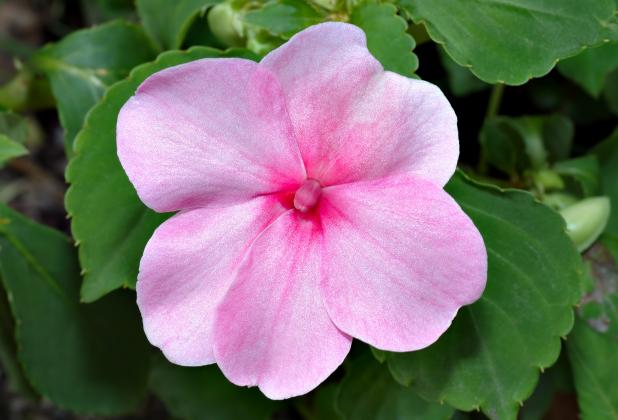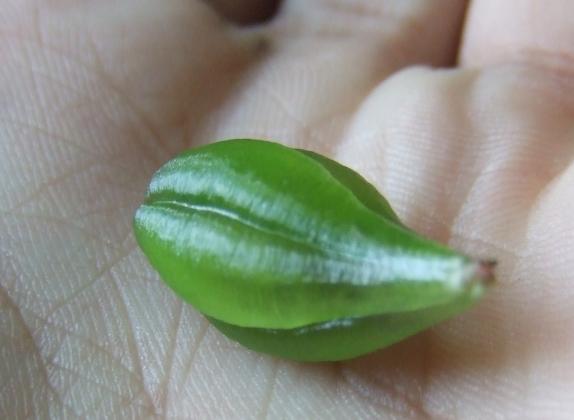Impatiens walleriana – From Zanzibar, Costa Rica to a garden near you
Backyard Horticulture
Impatiens walleriana is native to central Africa but is popular all over the world. It’s easy-to-grow, beautiful flowers come in a variety of colors and bloom in the shade. You’ve probably seen the plant in flowerbeds, as edging along paths and in hanging baskets. It can be bushy, growing from 6-inches to 2-feet tall with watery, semi-succulent stems. The elliptical leaves are toothed with serrated edges and are about 4.5-inches long by 2-inches wide. Some are variegated. They’re alternate but may be opposite near the top of the plant. They vary from light to dark green and sometimes have redish streaks. Flowers are various shades of pink, red, purple, orange and white with some bicolored. It has five petals, with one usually larger than the others, and is about 2-inches wide. There are three to five sepals. One is elongated with a nectar-filled tube, spur, that attracts pollinators such as butterflies, hummingbirds and any insect that can fit its mouth in the spur. The flower is mostly on one plane, flat, and is soft, delicate, easily damaged.
The genus Impatiens contains more than 1,000 species and is from the word “impatient,” referring to how the seedpods, fruiting capsules, burst open forcefully, releasing the seeds. Sometimes just touching the pod will release the seeds. The common names bizzy Lizzy and touch-me-not refer to how the seeds are released, but everyone I know just calls the plant impatiens. In Zanzibar, the plant was originally named I. Sultana or I. sultanii, for the Sultan of Zanzibar, which is where the plant was discovered by Europeans.
The name was changed to I. walleriana to honor Englishman Horace Waller (1833-1896), a missionary, anti-slavery activist and explorer of central Africa. He met the famous explorer David Livingstone (1813 - 1873) in 1861 and went on several expeditions with him. When people in England didn’t hear from Livingston for a while, journalist and explorer Henry Morton Stanley (1841 - 1904) went to Africa to look for him. When Stanley found him, he famously asked, “Dr. Livingstone, I presume?” After Livingstone’s death, his journals were published by Waller, who in 1864 was elected a fellow of the Royal Geographical Society.
The person responsible for creating the version of impatiens that we know today is Claude Hope (1907 - 2000). Born on a dairy farm in Sweet-water, Texas, he majored in ornamental horticulture at Texas Tech University in Lubbock. He received a master’s degree from Michigan State University and was working for the Agriculture Department in Maryland when the Japanese bombed Pearl Harbor in 1941. Hope was drafted into the Army when the U.S. declared war on Japan. Much of the fighting was in the Pacific, where malaria was a problem. Quinine, created from the cinchona tree, was used to treat the disease, but the supply had been seized by the Germans and Japanese. Hope was sent to Costa Rica to work on a project to develop an American supply of quinine. The project was cancelled and Hope sent home when the U.S. developed a synthetic drug. But Hope had become interested in the flora of Costa Rica and had grown to love the country.
After the war, Hope returned to Costa Rica, where he experimented with several plants. The University of Arkansas Cooperative Extension Service, uaex.edu, in their article “Plant of the Week: Sultana (Impatiens),” had more of Hope’s story. “Hope began improving impatiens in the mid-1950s, and by 1965 he had a series of eight selections in field trials in the United States. In 1968, he released the Elfin series, the first dwarf, free-flowering forms. He continued to improve impatiens over the years.” Hope died at his farm in Dulce Nombre de Jesus, Costa Rica. Some call him the Father of Impatiens. Almost all of the hundreds of varieties of I. walleriana on the market today are a descendant of Hope’s hybrids, but the Elfin cultivar is one of the most popular bedding plants in the world.
As human food, I. walleriana flowers are sprinkled on salads, used as a garnish and floated in drinks. It’s in the Food and Drug Administration Poison Plant Database at fda.gov. The National Institutes of Health, ncbi.nlm.nih.gov, in the article “The Antioxidant Changes in Ornamental Flowers during Development and Senescence” talked about edible flowers, including I. walleriana. “The source of nutraceutical compounds in human diet is almost exclusively provided by fruits and vegetables. However, flowers are becoming important sources of several bioactive compounds that can be added in the diet as food. In the ancient time flowers were mainly eaten for their medicinal properties rather than their nutritional value. Nowadays, several metabolomics studies revealed the chemical compositions of wild and ornamental flowers, showing the presence of important bioactive molecules ... Further works should be addressed on the quality of edible flowers after harvest and the development of technologies that can be used for maintaining the nutritional value during storage. The marketability of edible flowers will be possible if appropriate food processing and storage methods will be studied and designed in order to reduce quality losses from the field to the consumers.”
Deborah Richardson is a freelance reporter for The Examiner with a fondness for flora in its natural setting.






